Grace Under Pressure
Analyzing Two Decades Of RUSH's Unparalleled Prog Rock Prowess
By Andy Aledort, Guitar School, October 1996, transcribed by pwrwindows
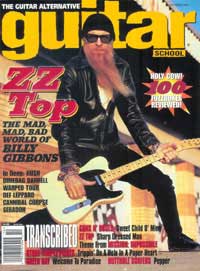
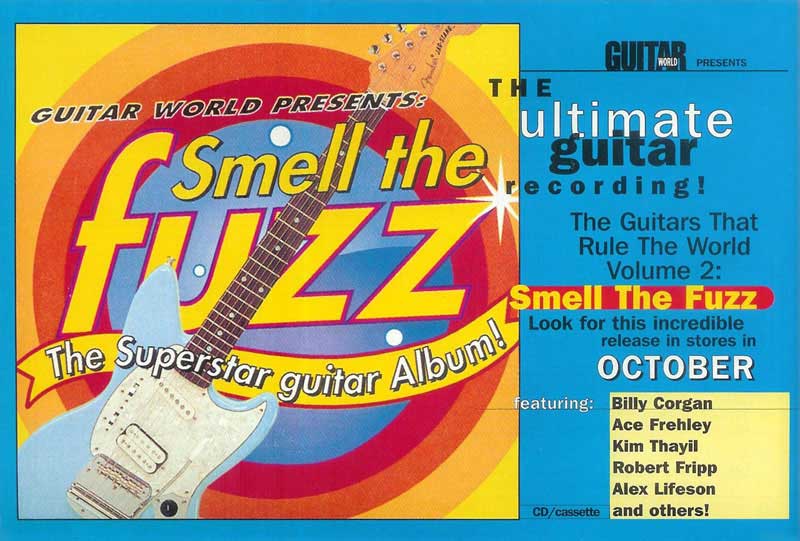
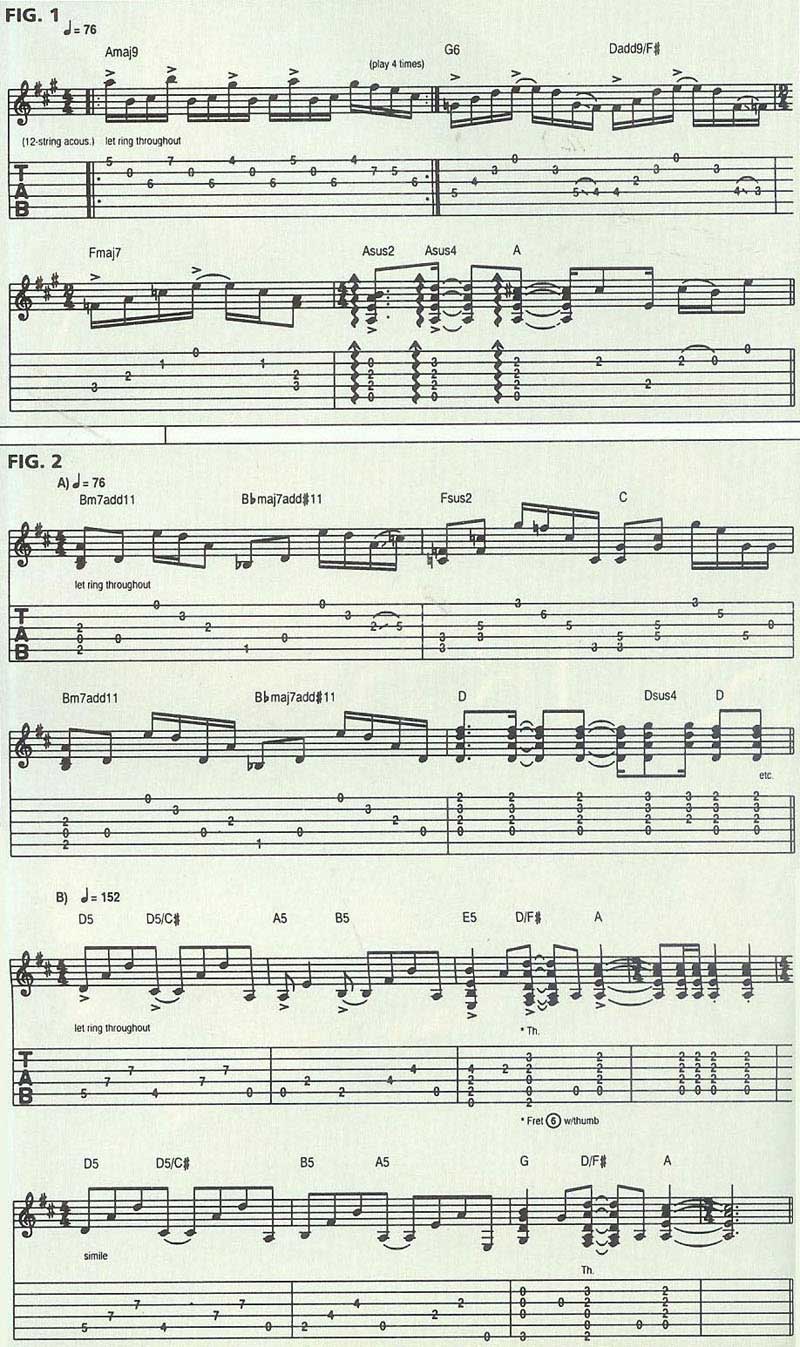
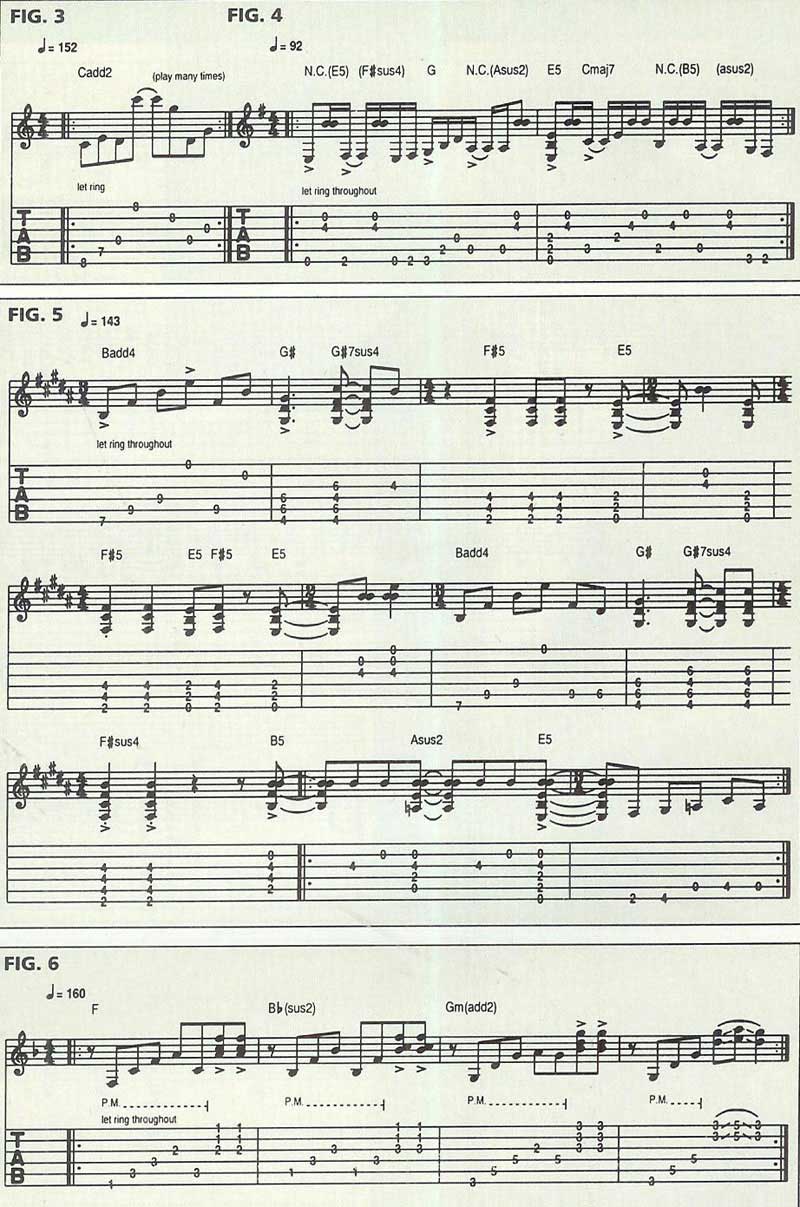

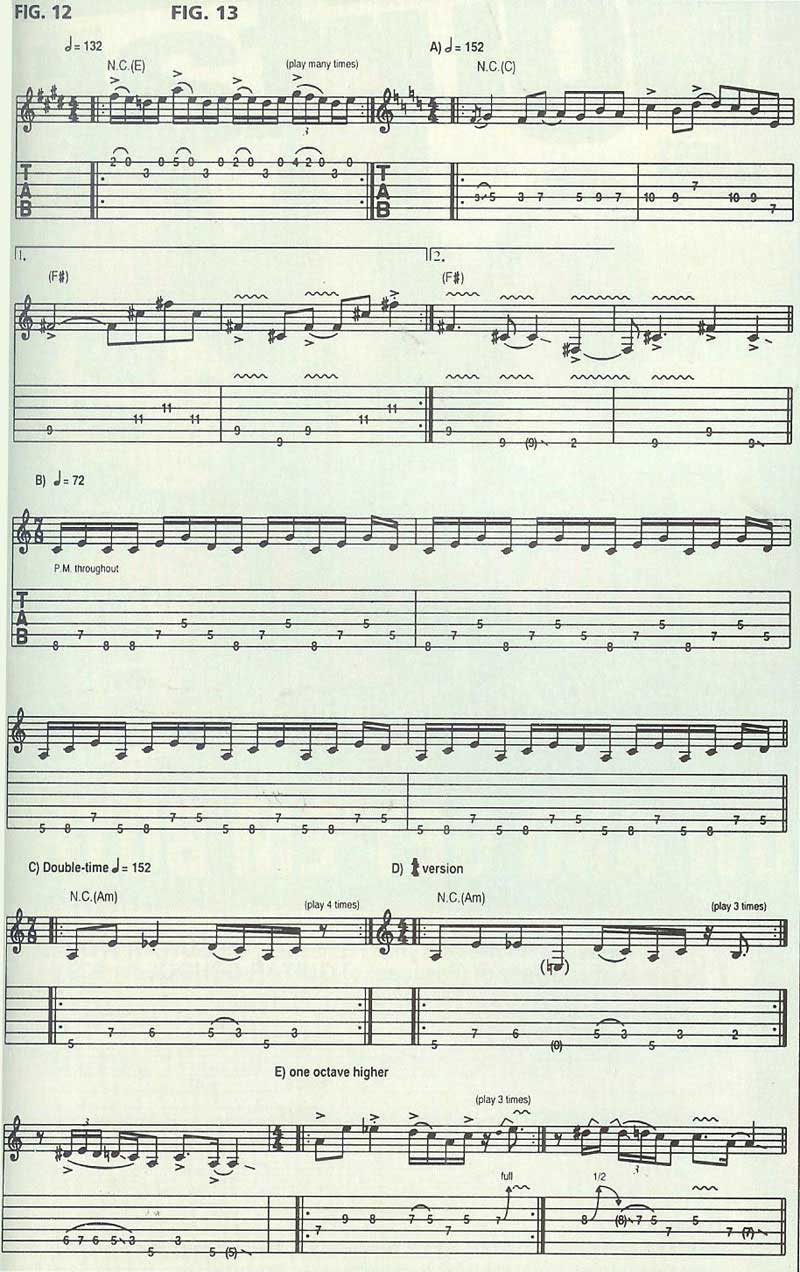
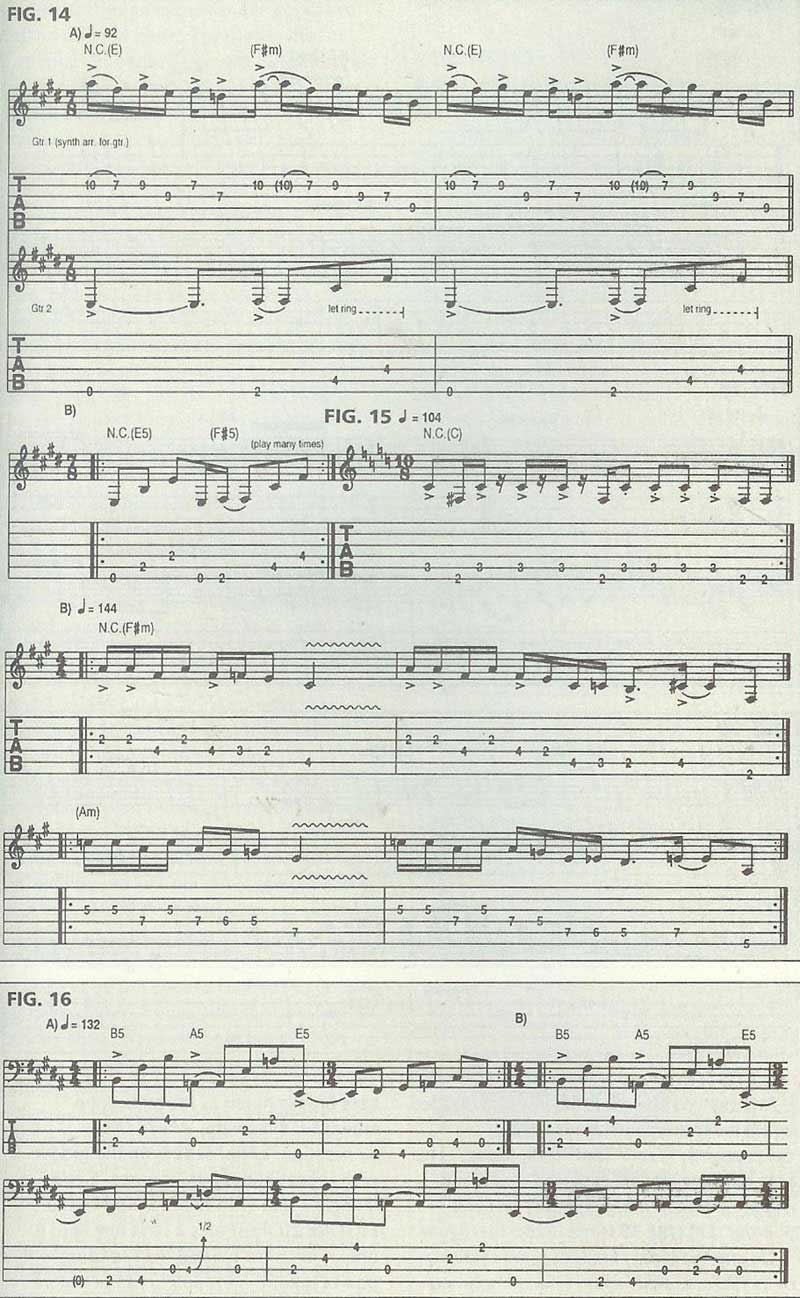

Through 20 years and nearly as many albums, Rush have established themselves as the masters of boldly experimental, metal-inflected progressive rock. As the conquering heroes of Canadian rock (sorry, Triumph), the band has achieved massive commercial success (each of its 19 records is certified either Gold or Platinum) without ever wavering from its pursuit of pure musical exploration. In the process Rush has amassed a song catalog filled with such rock radio staples as "Tom Sawyer," "Closer to the Heart" and "Distant Early Warning."
In this edition of In Deep... we'll examine many of the highlights of Rush's incredibly rich history and take a close look at Alex Lifeson's wide-ranging guitar work and Geddy lee's inimitable bass stylings.
"If I had to pick a defining moment," says Alex Lifeson, "it would have to be when we finished our fourth album, 2112. When that record was done, we felt like it was the beginning of our own sound."
Released in 1976, 2112 was Rush's breakthrough album, their first to crack Billboard's Top 100. This grandiose concept album features key elements of Lifeson's guitar style: abundant use of sweeping chordal arpeggios (an arpeggio is a chord played as single notes in succession), fused with aggressive power chords and bone-crunching single-note riffs.
Lifeson's most famous arpeggiated moment is, however, found on the follow-up to 2112, 1977's A Farewell to Kings. On that album, the opening to "Closer to the Heart" is played on an acoustic 12-string, utilizing a technique known as "oblique motion," which is when one or more tones (in this case, two) remain constant while another tone moves around. FIGURE 1 illustrates a similar figure. Be sure to allow all of the notes to sustain throughout, and take particular notice of the abundant use of open strings.
Regarding his affection for arpeggiating, Lifeson says, "You get all of that intertwined harmonic information overlapping, especially when you add a little bit of reverb or echo. It's a very effective compositional tool."
"I don't know if there's anyone on the planet who plays arpeggios as well as Alex," adds Geddy Lee. "He always makes them sound so original and melodically interesting. And they're quite internal; you have to really listen to appreciate the complexity."
Another excellent arpeggio example is heard on "Freewill," from 1980's Permanent Waves. At the pre-chorus, Lifeson switches from the song's main single-note theme to arpeggiated figures played in half-time. FIGURE 2A illustrates a rhythm figure along these lines. Notice in bar 1, in the switch from Bm7add11 to Bbmaj7add#11, that the only note that changes is the low root note. Again, be sure to allow all of the notes to sustain as long as possible. Like the "Closer to the Heart" riff, this one ends with a syncopated chordal figure utilizing suspended chords.
When "Freewill" switches to the chorus, Lifeson combines arpeggios with aggressive power chords. "I love that!" exclaims the guitarist. "I think the two elements complement each other very well, and I love shifting from one to the other."
FIGURE 2B illustrates a rhythm part along the lines of the "Freewill" chorus. Across this eight-bar figure, two bars of arpeggios are followed by two bars of hard-driving power chords.
An interesting, slightly deceptive chordal arpeggio is found behind the opening theme to "La Villa Strangiato," from 1978's Hemispheres. Notice that the open D string supplies the "add 2" of the Cadd2 chord. FIGURE 3 illustrates a similar pattern.
One of Rush's most powerful tunes is the ever-popular "Tom Sawyer," from 1981's Moving Pictures. For the pre-chorus, Lifeson devised a clever rhythm figure that is part arpeggio and part heavy, single-note lick. FIGURE 4 depicts a similar rhythm pattern. Throughout this figure, notice the use of the unison B notes which are sometimes played simultaneously and sometimes picked individually.
"At the time we recorded 'Tom Sawyer,' I didn't think it was any great shakes," says Lee. "But when I listen back to it now, I think a great combination of different influences came to light in that song."
Fueled by the strength of "Tom Sawyer," "Red Barchetta" and "Limelight," Moving Pictures is widely regarded as Rush's most important album. Lifeson's incredible guitar work contributes mightily to the overall strength of "Limelight," particularly the brutal, opening, power chord/heavy riff figure, the intricate chordal arpeggios fused with power chords through the verse and chorus sections, and the guitar solos - some of Lifeson's best.
FIGURE 5 illustrates a rhythm pattern along the lines of the "limelight" verse section. Notice the seamless blend of arpeggios and power chords, as well as the sharply syncopated feel, aided by the time signature shifting between 3/4 and 4/4 . When playing this figure, strive for smooth transitions.
For the last two bars of this figure, Lifeson plays a rhythm part based on the song's main riff; both figures are built on the power chord/riff approach. More on these types of figures in a moment.
By the time the band recorded Signals in 1982, Rush was infusing a wider palette of sounds and influences into its music. The Police, riding high on the strength of such hits as "Don't Stand So Close to Me" and "Every Little Thing She Does is Magic," influenced Rush in a number of ways: Lifeson moved toward a more textural, Andy Summers-like guitar approach; Geddy lee laid down simpler, more melodic bass lines; and a reggae feel introduced to mainstream pop by the Police, found its way onto the album.
The Police's influence is particularly evident on "New World Man," Rush's biggest single. Most of the tune finds Lifeson choosing a clean tone treated with a combination of ambient and slap-back delays, with palm-muting added to attain a percussive attack - an approach straight out of the Andy Summers school. FIGURE 6 illustrates a pattern along the lines of the chorus figure. Notice in particular the chordal accents on beat four of each bar; moving from palm-muted single notes to sharply attacked chords is a device heard commonly in reggae.
As previously mentioned, another of Lifeson's favorite techniques in the creation of rhythm parts is the use of power chords in conjunction with single-note riffs. A prime example of this technique is found on the intro to "The Spirit of Radio," from Permanent Waves. FIGURE 7A depicts a similar figure. Here, Lifeson connects the E5 and A5 chords with two three-note licks; the overall harmonic environment reflects E Mixolydian (E F# G# A B C# D), with two added passing tones, G natural and C natural.
For the verse section of this tune, Lifeson uses an arpeggio-like approach to acid single notes to the power-chord heavy figure. FIGURE 7B is along these lines. Be sure to allow all notes to sustain throughout.
One of Rush's most effective uses of the power chord/riff concept is heard on the "Limelight" intro. The first rhythm figure played in the song is a heavy single-note lick, based on the E major scale (E F# G# A B C# D#). It is followed by power chords akin to FIGURE 8A. This figure is followed by a shift in key to B major, where B5, Asus2 and E5 power chords are followed by a similar Single-note lick . FIGURE 8B illustrates a figure along these lines. The most effective element in this power chord figure is the sustained unison B notes present in each of the chords, which supply a powerful, singing quality to the entire figure.
On one of the early themes in "La Villa Strangiato," from Hemispheres, Lifeson follows up power chords (all major chords in this instance) with a pull-off lick based on A Mixolydian (A B C# D E F# G).FIGURE 9 simulates this rhythm figure.
Another great tune in the Rush catalogue is "Distant Early Warning," from 1984's Grace Under Pressure, a song Lee holds in high regard. "Every once in a while we'll do a song that wraps up what we're all about, and 'Distant Early Warning' is one of those." Lee adds, '''Subdivisions' is another. If you had to describe the band to someone in one song, 'Distant Early Warning' would do it."
One of the primary rhythm figures in "Distant Early Warning" combines sharply attacked chords with it repeated low A pedal tone, with alternating bars of 4/4 and 3/4. This figure appears at the pre-chorus, And FIGURE 10A is along these lines. Here, power chords are combined with single notes, but the figure is mostly comprised of chords.
At the second verse, the opposite concept is used: Lifeson plays a figure that is nearly all single notes with the chordal accents thrown in on the upbeat of beat 4 in bars 1 and 3. All single notes are palm-muted. FIGURE 10B simulates this rhythm figure.
Another riff that combines power chords with single notes is the one heard during the verse section of "Tom Sawyer." Here, a syncopated low E pedal tone is played against sustained E5, Dsus2, A7sus4 and Cadd2 chords, not unlike FIGURE 11. In the last bar of this example, a descending Csus2-G/B-A7sus4 chord progression is played in an aggressive, syncopated rhythm.
Now let's take a look at some of the great single-note figures Alex Lifeson has devised over the years. For the opening of "The Spirit of Radio," Lifeson plays a fast lick using open strings and lots of pull-offs. FIGURE 12 depicts a lick along these lines. It is trickier than it looks, so be sure to slowly work up to speed.
For one of the early themes in "La Villa Strangiato," Lifeson plays a single-note line that moves between C major (C D E F G A B) and the tritone, F# (plus the fifth of F#, C#) in a most clever fashion. This unusual melody is not unlike that illustrated in FIGURE 13A.
Following the guitar solo in this tune, the song shifts to half time and a 7/8 signature. Within this section, Lifeson plays a single-note riff based on a C major triad (C E G) with the inclusion of the second, D, for two bars, followed by a very similar lick based on an A minor triad (A C E) with the inclusion of the fourth, D. This figure is palm-muted throughout. FIGURE 13B depicts a similar line.
When the song shifts back to double time, another figure in 7/8 is introduced, based this time on the A blues scale (A C D Eb E G). FIGURE 13C is not unlike this classic riff.
The idea is further developed by switching to 4/4 and playing what is essentially the same lick, altered for the new time signature. After this figure is played in its original octave, it is moved up an octave. FIGURES 13D and E are along these lines, respectively.
All of these figures point to the influence British progressive bands such as Yes, King Crimson and Jethro Tull had on Rush.
A Yes-ish figure is, in fact, heard in the synthesizer break melody of "Tom Sawyer." Again in 7/8, the 16-note synth melody is joined by a low single-note riff that alludes to E and F#m chords. FIGURE 14A is along the lines of this section, with the synth melody arranged for guitar.
For the outro to "Torn Sawyer," the previous low-note figure is elaborated on by featuring fully arpeggiated E5 and F#5 chords, as in FIGURE 14B. This heavy single-note lick is somewhat reminiscent of the Mahavishnu Orchestra (led by guitarist extraordinaire John McLaughlin) songs "Meeting of the Spirits" and "Birds of Fire."
Another stellar tune from Moving Pictures is the instrumental "YYZ." "All of our instrumentals come out of us just jamming together," says Geddy Lee. "Jamming is recess; there's no vocal melody, there are no lyrics...WEE-HA!"
The opening to "YYZ" features yet another odd time signature, 10/8, with a heavily syncopated riff consisting of only the root note, C, and the tritone, F#. FIGURE 15A is not unlike this opening single-note figure.
When the song shifts to 4/4 and a faster tempo, Lee and Lifeson play a quick line in unison. The first half of the lick is based on the F# blues scale (F# A B C C# E), and the second half is based on the A blues scale (A C D Eb E G). FIGURE 15B depicts similar figures.
No discussion of Rush's massive collection of prog-rock gems would be complete without examining some of Geddy Lee's innovative bass lines. A traditionalist at heart, Lee frequently utilizes the standard "root-fifth-root" shape, a staple of rock bass playing. This concept is evident in the intro to "Limelight." FIGURE 16 is along the lines of Lee's line.
In a live situation, Lee spices things up with subtle changes in the original figures. FIGURE 16 illustrates some of the typical deviations Lee likes to throw in when he's on stage.
Since Lee is the band's bassist and vocalist, many of his lines are structured around the vocal part. For the chorus of "Limelight," Lee plays a spare figure through the first six bars, throwing in a bit of flash at the first opportunity, in bar 7. In bars 9 and 10, he adds movement to the line by jumping octaves. FIGURE 17 is along the lines of what Lee plays live in the "Limelight" chorus.
One of the best examples of Lee's bass playing is heard on the intro to "Distant Early Warning." This hyperactive figure is equally strong in terms of melody and rhythm. A favorite of Lee's, the line utilizes similar shapes through all of the chord changes, and is similar to the line shown in FIGURE 18.
Another Lee favorite is the line he conjured up for the instrumental from 1993's Counterparts, "Leave That Thing Alone." This King Crimson-ish line is played in 3/4 and makes abundant use of hammer-ons and pull-offs. FIGURE 19 is not unlike this figure.
During the crazy, freak-out jam sections of "YYZ," Lee adds some unaccompanied bass breaks much as his hero, John Entwistle, did on the Who's "My Generation." After setting up the groove with repealed three-bar figures, Geddy launches into wild two-bar improvisations. FIGURE 20 illustrates a bass line akin to one of his most twisted licks, ending with a pair of natural harmonic (N.H.) clusters.